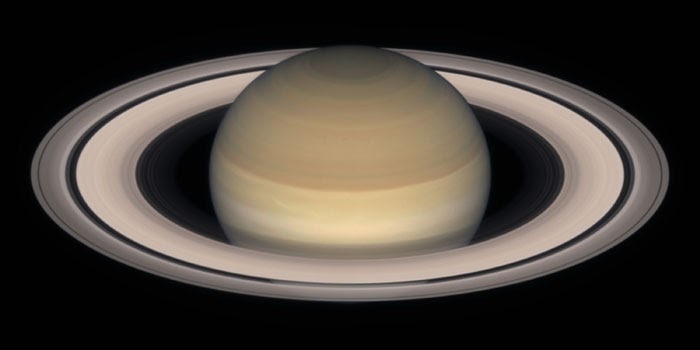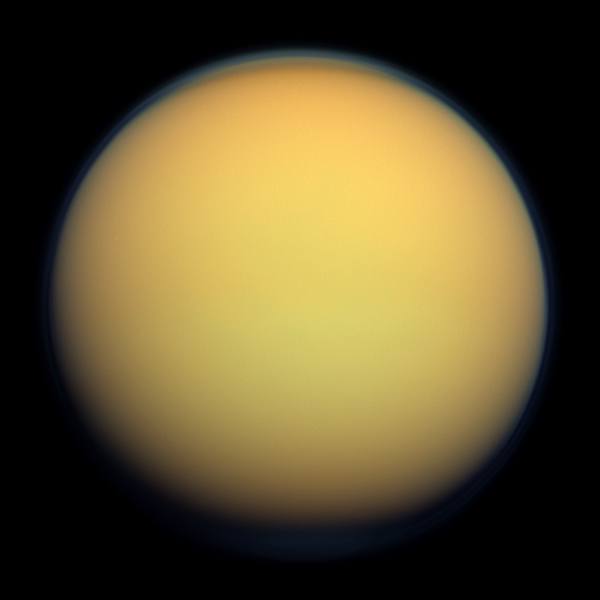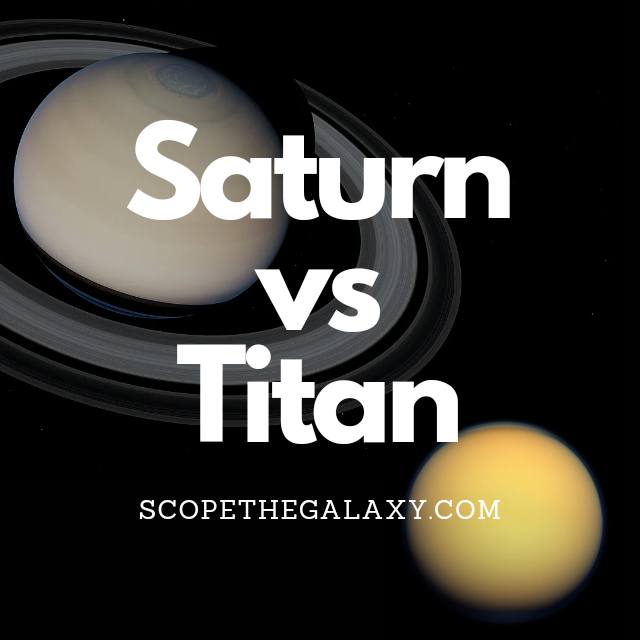*This post may contain affiliate links. This means we may make a commission if you purchase an item using one of our links*
The main differences between Saturn and Titan are that Saturn is the gas giant that Titan orbits whilst Titan is Saturn’s biggest moon and the second biggest in our solar system. Their general composition is very different where Titan has a water cycle similar to Earth whereas Saturn is a gas giant comprised mostly of hydrogen with ices containing elements of Ammonia.
There are other various unique features between the two so, continue reading for a more thorough breakdown of both celestial objects along with the similarities and differences that the both have.
What Is The Planet Saturn?
Table of Contents

Saturn is the second largest planet in our solar system that has 7 rings surrounding its gaseous exterior. It’s also the 6th farthest planet from the Sun.
As Saturn falls under the gas giant moniker, the planet is mostly made up of gases. However, Saturn’s composition is a little different from Jupiter’s where its atmosphere is a mixture of hydrogen and ices containing elements of Ammonia.
It’s core on the other hand is comprised of a dense core of nickel and iron, which is then surrounded by rocks compressed so strongly that it allows the planets core to reach scorching hot temperatures of 11,700+ degrees Celsius.
On the other hand, It’s gaseous atmosphere is far cooler. The exterior generally sits in the extreme sub zero range where Saturn’s temperatures averages around -138 degrees Celsius.
This is generally constant throughout the yellow ringed giants day to day. In fact it’s much colder than even the coldest place on Earth, which would be Eastern Antarctic Plateau, Antarctica that hits -94 degrees Celsius, which is more than 40 degrees Celsius warmer.
Being so large (116,460km), Saturn’s gravitational pull is obviously strong. That’s why over it’s 4.5 billion years of existence, beyond its rings, this yellow gas giant has managed to accumulate 82 different moons along with other smaller interstellar debris that now orbit it.
In fact it’s largest moon Titan is literally bigger than one of the 8 planets orbiting the Sun, Mercury.
Saturn also orbits the Sun but, as the 6th farthest planet from it, it does mean a singular orbit will take it 29.4 Earth years to complete. In comparison to its axial orbit which only takes 10.7 hours, this is exponentially longer.
What Is Titan?

Titan is Saturn’s largest moon and the second biggest moon in the entire solar system, with a diameter of 5,150km. This would make it even larger than the planet Mercury which is only 4,879km, and significantly larger than Pluto also.
As a result, Titan’s gravitational strength stands at around 1.352 m/s²
It is the only natural satellite in our solar system that is composed similarly to Earth, where it has a thick atmosphere made primarily of nitrogen (95%) along with smaller amounts of methane (5%). It has rivers and lakes on its surface along with a water cycle very similar to that of Earth, where essentially water evaporates and eventually lands on the satellites surface.
Therefore, much like Earth, Titan has a terrestrial based body but, there is a difference in their atmospheric pressure. The pressure on Titan’s surface is around 60% greater than that of Earth’s surface but, it isn’t nearly as dense.
Nevertheless, it is still far denser than most other bodies at 1.88 g/cm³. As a result, Titan’s mass is 1.345×10^23 kg.
In regards to its temperature, Titan is on the colder side where it averages around -179 degrees Celsius whilst its core’s temperature is actually very cold in comparison to other entities falling between 226 – 526 degrees Celsius.
As Saturn is the 6th farthest planet from the Sun, it will take Titan roughly the same amount of time to orbit the Sun, which would fall around 29.4 years.
It takes Titan 15 days and 22 hours to orbit Saturn. A day is 15 days and 22 hours also as it is tidally locked to the gas giant.
Similarities Between Saturn And Titan
There are a few similarities that the two have, which in this case includes the following:
- Both are a spherical shape.
- Both have a hotter core.
- Titan does orbit Saturn.
- Both are part of the same solar system.
- Both take the same amount of time to orbit the Sun at 29.4 years.
Differences Between Saturn And Titan
In regards to the differences they would include the below:
- Saturn is far bigger with a diameter of 116,460km whilst Titan has a diameter of 5,150km making Saturn the second largest planet and Titan the second largest natural satellite/moon.
- Saturn is a gas based giant whilst Titan is a terrestrial based natural satellite.
- Titan has 0 rings surrounding it whilst Saturn has 7.
- Saturn’s density is 0.687 g/m³ whereas Titan is more dense at 1.88 g/cm³.
- Titan is tidally locked to Saturn whilst Saturn is not tidally locked to any other object.
- Saturn has a mass of 5.683 × 10^26 kg compared to Titan’s that is 1.345×10^23 kg.
- Titan has an atmosphere similar to that of Earth where it is 95% nitrogen and 5% methane whilst Saturn’s atmosphere is composed of a little over 96% hydrogen and 3% helium.
- Saturn’s wind speeds are around 1,800km/h meaning it does have the second fastest wind speeds in our solar system whilst Titan’s wind speeds are far slower at around 0.3m/s which is equal to around 1.08 km/h.
- Titan has a temperature of -179 degrees on average which is more than Saturn’s that averages -134 degrees Celsius.
- In regards to their core temperatures, Saturn’s is very hot at 11,700 degrees Celsius whilst Titan’s is between 226 – 526 degrees Celsius.
- In regards to gravitational strength, Titan’s is 1.352 m/s² whilst Saturn has far stronger gravitational pull of 10.44 m/s².
- A day on Saturn takes 10.7 hours whilst a day on Titan will take roughly 15 day and 22 hours.
- Saturn’s axial tilt is 26.73 degrees whilst Titan’s is 27 degrees.
- Saturn orbits the Sun in a circular pattern whereas Titan orbits Saturn elliptically.
- Saturn has 82 moons whilst Titan has no moons orbiting it.
Summary
Although both are located in each others local region, they differ significantly, whether it be their differences in size, composition, temperature and beyond.
As a result Saturn and Titan cannot truly be compared, with the main connector between the being the fact Titan orbits Saturn. Besides this fact and other smaller nuances, Titan and Saturn function very differently from one another.

